Fishing Report: July 16, 2021

Red tide impacts prevalent inshore vs. offshore
The red tide issues we are seeing pervasively inshore are not affecting our near shore and offshore fishery in the short term, reports Captain Dylan Hubbard of Hubbard’s Marina.
MADEIRA BEACH, Fla. - Every Friday morning, Captain Dylan Hubbard of Hubbard's Marina joins Good Day to fill viewers in on his fishing forecast as we head into the weekend.
Here is his fishing report for July 16, 2021.
**Editor's note: This report was published just before FWC announced catch-and-release restrictions in Tampa Bay for snook, redfish, and spotted seatrout. It went into effective immediately and will continue through September 16.
Inshore
Red tide is definitely impacting our fisheries in a great, great way. We're seeing a super-concentrated red tide bloom inside Tampa Bay, especially around the southern edge of Pinellas County. That super concentrated section that was kind of focused on the south shore of Tampa Bay, Elsa came up and blew that southwest wind and took a lot of that right to and around downtown St. Pete, all around to Fort De Soto Park.
Plus, we're seeing it kill seagrass beds. We're seeing it take out a lot of our structures in the estuary, which is home to primarily the entire food chain at the beginning of their life stages. So we have a really drastic event going on right now that we're going to see far-reaching effects on. There's talk among the FWC right now potentially closing some species again in an emergency executive order to protect a lot of these species being impacted.
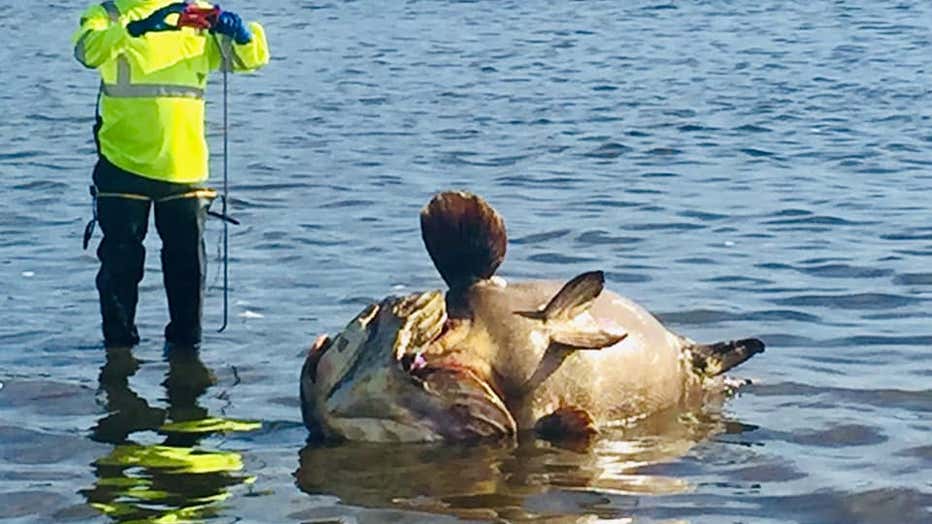
Credit: Wendy Wesley
Basically, we have all these different factors at play with the pollutants, the salinity level, and then that organism was present due to that west wind prior to Elsa and then Elsa came through like a big wooden spoon and mixed up Tampa Bay. All those ingredients mixed together and exploded into the situation we have now.
Right now at least, it's concentrated around the bay and the back bay areas. So on a hard, inbound tide, we get an influx of some really clean Gulf water. This stuff doesn't really protrude far into the Gulf so as that incoming tide comes in, the water cleans up.
The fishing around John's Pass, Clearwater Pass, Pass-a-Grille has actually been fairly decent on a hard, inbound tide, especially up to the north – once you're north of the Honeymoon Island area.
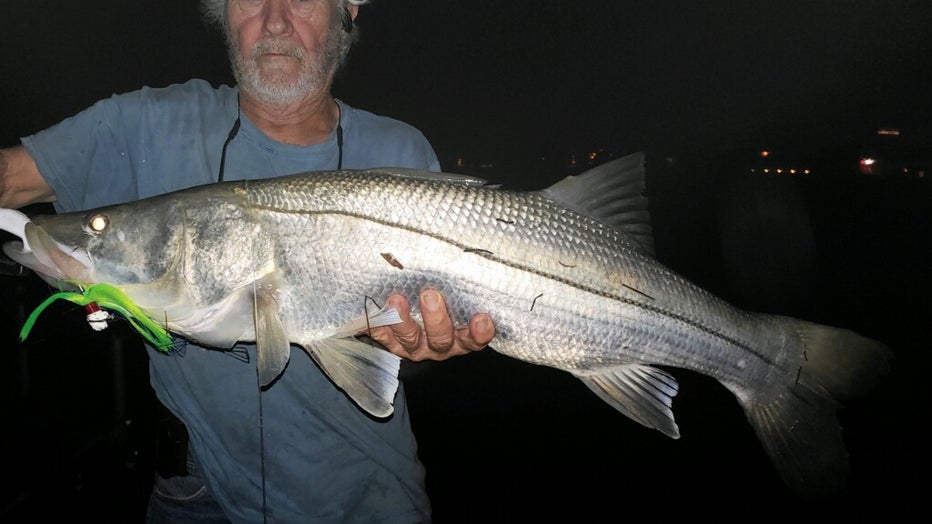
Snook (Credit: Hubbard's Marina)
Prior to Friday, inside John's Pass and north, we've been seeing some nice snook, redfish, trout and even some pompano caught on those hard, inbound tides, but FWC has since announced catch-and-release measures for snook redfish and spotted seatrout in Tampa Bay.
Near shore and offshore
Luckily, the red tide issues we are seeing pervasively inshore are not affecting our near shore and offshore fishery in the short term. However, what concerns me for the future for our fisheries in the central west coast region.
These large-scale fish kills may take a big effect on future recruitment classes of these near shore and offshore species like gag grouper, mangrove snapper, lane snapper, red grouper, and many other species that start their juvenile life cycle and development inshore in the estuaries.
I’m hoping we don’t see a downward trend near shore and offshore moving forward due to these large-scale events plaguing adjacent fisheries.
Near shore currently, we are seeing a great bite of lane snapper continually active around 60-100 feet of water with some decent mangrove snapper action mixed in there too. Occasional red grouper are still biting steadily in the near shore waters but they get larger and more concentrated beyond the deepest near shore waters that extend out to around 100 feet of water.
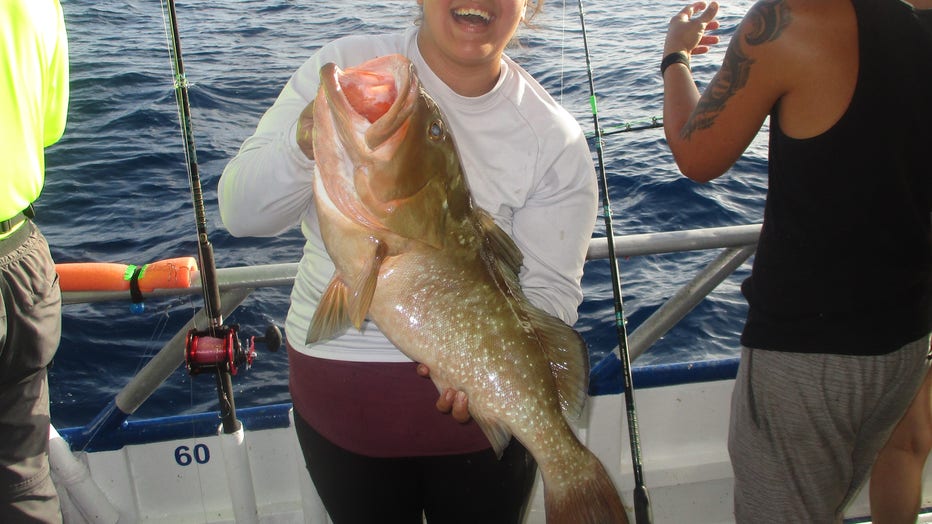
Red grouper (Credit: Hubbard's Marina)
Hogfish action is virtually nonexistent at this time, but we are seeing them randomly from time to time in the near shore areas. Pelagic wise there is not much to speak of near shore but there are still sparsely populated mackerel along the beaches out to around 60 feet of water.
Offshore is the focus still as we are in the depths of red snapper season taking advantage of this short season and great bite. However, the weather has been a little tricky with hurricanes and such making it tough to get out deep. When we can, the fishing has been outstanding overall.
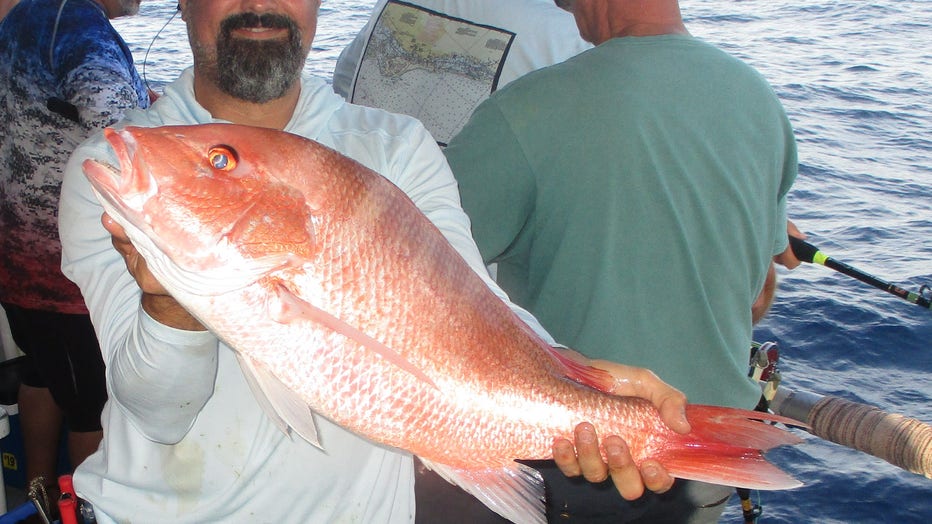
Red snapper (Credit: Hubbard's Marina)
Red snapper concentrations haven’t been incredible but were finding a slow and steady bite of these highly sought-after fish in a very large average size anywhere from around 160-200 feet of water. We do see them as shallow as around 100-120 feet of water but if you want to find more steady action you must start closer to around 140 feet of water and the deeper you go the better the action seems to be.
The best bait lately seems to be the larger more oily and smelly cut dead baits like the whole squid, Bonita strips, or the octopus. We are still seeing plenty on the big threadfins and sardines too.
Gag grouper action remains strong despite our inability to get live bait out there on most recent trips. Since the backside of Elsa moved through, it helps the red tide food to stir up and those organisms thrived. Most of the big gags we have seen lately have been on the white grunts we catch on our near shore during the 5-hour half days. Those guys are going back on a 39-hour to drop down or use the big live baits to fool those big gag grouper.
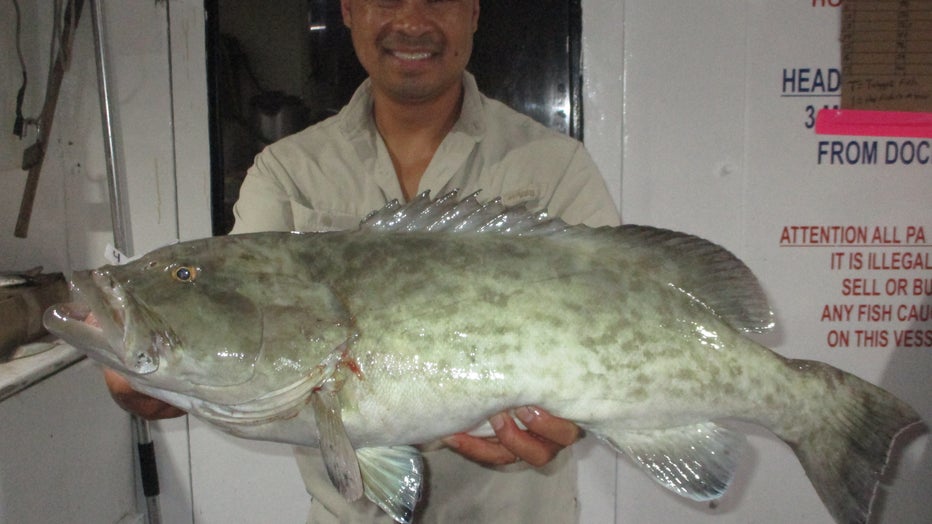
Gag grouper (Credit: Hubbard's Marina)
Minimally, you need around 80lb test when fishing out deeper for gag grouper offshore but if I was dropping a big bait down on a 100lb leader, I would want to have a reel with at least 40-45lbs of drag. Also, keep in mind your hook size needs to carry with your size of bait. If you plan on using a 3lb bait you need some 125lb tests and then make sure we have conventional rods to get out there deep and hunt some bigger gags and red snapper.
Pelagic action has been fired up offshore. We are seeing right now some big mahi mahi in the bull dolphin range. Plus, occasionally, some wahoo and tuna join the fun.
However, the big news has been the prolific kingfish around the offshore waters as of late. We were seeing them in all the offshore waters especially on the recent 39 hours, even dead baits were hooking some solid kingfish.
DON’T BE A FOOL, bring a venting tool & Descending device
Keep in mind the importance of dead discards and discard mortality when engaged in near shore or offshore fishing. How many do you know right now that are all for catching and releasing snook, redfish, and trout but will be the first in line to kill a mangrove snapper, gag grouper, or red snapper? But the attitude completely changes when discussing these offshore species?
Plus, the same person inshore that will hold their breath and wet their hands before handling a breeder snook will go offshore and then cull through 20 red snapper before keeping their two red snapper they deem large enough to fill their two-fish bag limits. Meanwhile, the other 18 they released will often end up suffering fatal damage if not properly descended or vented?
Please help us to spread the word on the importance of descending or venting your released fish. Descending devices are most easy to use and quick to pick up on their use. They are most effective for most anglers.
However, an expert and precise angler with proper training and tons of experience can use a venting tool properly with similar outcomes. A venting tool requires you to pierce the fish while most descending devices are much less invasive. While using a venting tool, it is imperative you pierce them in the exact right spot, and you do not go but a quarter-inch or less in the fish. Most venting tools require you to ‘choke up’ on the tool to prevent over-penetration into major organs.
When fishing deep water, especially in the hot summer months, please make sure to treat all fish intended to be released like that breeder snook inshore and minimize the time it takes you to get him from the bottom to the boat using heavier proper tackle, not an ultra-light spinning reel.
Then once onboard, minimize the time out of the water. Then use a proper de-hooking tool and then, for the love of God, use a descending device or venting tool PROPERLY to ensure that fish has a chance to live another day.
Three things will help ensure the survivability of those fish released offshore:
- Making sure they are brought up quickly and do not expend all their energy in the fight.
- Make sure they are unhooked smoothly, easily, and as quickly as possible.
- Finally, make sure they spend the least amount of time at the surface at negative pressures where barotrauma exponentially increases its effect with each passing second.
Also, keep in mind when the water is warm, there is less dissolved oxygen content and the chances of barotrauma increase even more while its effects can be even more deadly.
LINK: Here’s all the information and more on barotrauma and how to mitigate that fatal damage to your future offshore catch
**Note: I recommend the Salt Strong articles at the bottom of the page under ‘webpages.’ I helped them develop those personally.
STATE SURVEY to improve recreational data and access
It is imperative that you have your Gulf Reef Fish survey endorsement on your fishing license.
You should get one if you are a private recreational angler or diver fishing from a private boat anywhere in Florida who intends to harvest, attempt to harvest or possess one or more of the following reef fish species: mutton snapper, yellowtail snapper, hogfish, red snapper, vermilion snapper, gag grouper, red grouper, black grouper, greater amberjack, lesser amberjack, banded rudderfish, almaco jack, gray triggerfish, Gag grouper, Red grouper, Scamp grouper, Mangrove snapper, Lane snapper, Kingfish, Tuna, or Mahi mahi.
Here is all the information and more on that program and how you can sign up.
TERMS OF REFERENCE:
INSHORE – from the back bays out to the bridges and including right on the beaches
NEAR SHORE – From the beaches out to 20 miles, or up to 100ft of water
OFFSHORE – from 20 miles or 100ft and beyond
For more fishing reports, photos, videos and more check out Hubbard’s Marina on Facebook, Instagram, YouTube, or Snapchat. Just simply search "HubbardsMarina" and do not forget our family motto, "If you’re too busy to go fishing, you’re just too busy!

